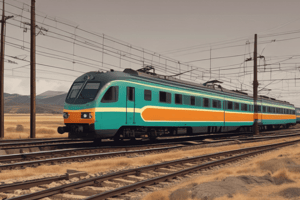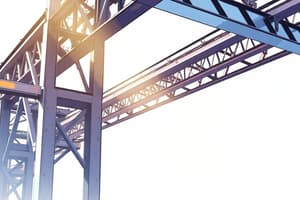Podcast
Questions and Answers
What type of tension member is a cantilever?
What type of tension member is a cantilever?
- Curved
- Horizontal
- Transverse
- Vertical (correct)
Which tension member consists of rods connected by joints to form triangles?
Which tension member consists of rods connected by joints to form triangles?
- Trusses (correct)
- Beams
- Arches
- Columns
What type of structure resists loads applied perpendicularly to their axis?
What type of structure resists loads applied perpendicularly to their axis?
- Arches
- Beams (correct)
- Cables
- Trusses
Which member supports loads along its entire height or above the foundations?
Which member supports loads along its entire height or above the foundations?
What are thin wires used to suspend or transmit loads over long distances?
What are thin wires used to suspend or transmit loads over long distances?
What does grip length refer to in bolt fastening and installation?
What does grip length refer to in bolt fastening and installation?
Which type of tension member transfers loads from supports to points of thrust without a direct line of force?
Which type of tension member transfers loads from supports to points of thrust without a direct line of force?
What is shear lag in the context of a column subjected to axial compression?
What is shear lag in the context of a column subjected to axial compression?
How does a long joint differ from a conventional short joint in terms of bond strength?
How does a long joint differ from a conventional short joint in terms of bond strength?
When does block shear failure occur in tension members?
When does block shear failure occur in tension members?
What factors influence the load-carrying capacity of a tension member?
What factors influence the load-carrying capacity of a tension member?
Which material is commonly used for tension members based on the text?
Which material is commonly used for tension members based on the text?
Study Notes
Tension Members: Types, Shear Lag, Long Joint, Grip Length, Block Shear Failure & Load Carrying Capacity
Tension members are structural components subjected primarily to axial forces, such as tensile forces, compressive forces, bending moments, or shearing forces. In engineering and construction, they are used in various applications like bridges, towers, cables, etc., where they have to withstand complex loading conditions. Here's a comprehensive overview of types and related concepts of tension members:
Types of Tension Members:
- Cantilevers: A cantilever is a type of vertical beam fixed at one end and free at the other. They can support loads by deflecting both vertically and horizontally.
- Trusses: These structures consist of rods connected by joints to form triangles, which distribute loads efficiently among its members.
- Arches: Arches are curved structures that transfer loads from supports to points of thrust without any direct line of force between them.
- Beams: Beams are horizontal or sloping structural elements designed to resist loads applied perpendicularly to their axis.
- Columns: Columns are vertical members supporting loads along their entire height or for some distance above their foundations.
- Cables: Cables are thin wires used to suspend or transmit loads over long distances.
Shear Lag:
Shear lag refers to the lateral displacement of material caused by the sliding action between layers when a column is subjected to axial compression. It results in reduced effective cross-sectional area available for resisting an external load, thereby affecting the load-carrying capacity of the member.
Long Joint:
A long joint is a connection between two parts made using a connector that extends beyond the crosshatch junction of the punch and the hole ring. This design ensures higher bond strength compared to conventional short joints because it provides more contact surface for the fillet and lessens the likelihood of crack initiation.
Grip Length:
Grip length is the portion of a bolt shank embedded in a material whose bearing stress is exceeded due to high tensile forces during installation. To ensure adequate safety against buckling under high torque, the grip length must meet certain standards based on the material being fastened.
Block Shear Failure:
Block shear failure occurs when a loaded edge, which would otherwise remain straight, curves outward due to bending in the presence of transverse forces. This behavior is common in tension members, particularly when there is an initial imperfection in the members, causing the formation of localized plastic deformation.
Load Carrying Capacity:
The load carrying capacity of a tension member depends on various factors such as the material properties, dimensions, geometry, boundary conditions, and loading conditions. Typical materials used for tension members include steel, concrete, timber, and composites. Each has its unique characteristics influencing the maximum load-carrying capacity.
Studying That Suits You
Use AI to generate personalized quizzes and flashcards to suit your learning preferences.
Description
Explore the types, shear lag, long joint, grip length, block shear failure, and load carrying capacity of tension members in engineering and construction. Understand how these structural components withstand complex loading conditions in various applications like bridges, towers, and cables.




